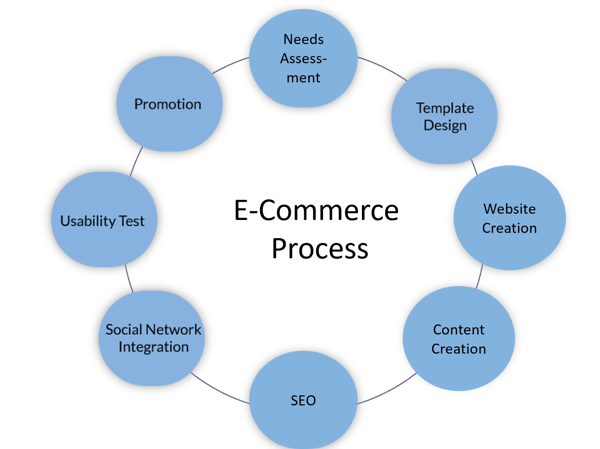What advantages does e-commerce offer B2B and B2C companies or customers?
Any delay in the purchase process is eliminated and can, therefore, enable barrier-free trade. The customer can order and pay "directly" for self-selected and personalized products or services online from the comfort of his couch. E-commerce also offers you the possibility to advise your customers directly and in the best possible way, so there is a huge opportunity for a broad exchange of information between you and your customer. Conversely, this means that you can offer your customer in advance information about the desired service that he needs. The possibilities are therefore often better than in conventional offline trading.
In the digital age, e-commerce is one of the core business models that has become very complex and has developed into a self-organized business model in its own right. In e-commerce, it depends very much on a good performance of marketing methods, affiliate marketing, search engine marketing and search engine optimization - because only then you can be found by customers for the terms for which you should be searched. While the e-commerce business used to be underdeveloped in the past, since the advent of the online giant Amazon at the latest, an increasing professionalization can be seen, which is also reflected in the ever-growing range of ready-made shop systems. The simplicity and convenience of e-commerce make for a pleasant and satisfying shopping experience, thus promoting customer loyalty.

If you want to create an online shop, the first step is to think about which requirements the shop has to meet:
The first step is to think about which shop system is best suited for your project.
You can choose either a shop construction kit or a self-hosted shop software. If you want to go the faster and cheaper way and slowly approach the topic of e-commerce, then the choice of a shop construction kit is recommended. Such systems do not require any programming knowledge, are quickly set up, and cost little. However, they lack flexibility and functionality. A large e-commerce company will probably not be able to be built up with such shop systems. Should you decide to do so, you can find out more about the details from providers such as Strato, 1&1, or Jimdo. If you are serious about e-commerce and would like to generate a certain amount of revenue, then you can't avoid a real shop software. A good shop software can be completely adapted in design, individual functions can be added and all important payment methods can be embedded. If you are technically very fit, then such software can be operated economically. If the necessary know-how in the area of web development is missing, then external agencies are available to you, which take over the complete technical handling.
According to various studies, the selection of the right payment method is probably the decisive success factor in e-commerce: If the payment method preferred by the user is not offered, the purchase is often canceled. But which online payment systems are the most popular in e-commerce in Germany?
A study by Sage at the beginning of 2015 identified these four payment methods:
 PayPal
PayPal Credit Card
Credit Card Pay by bill
Pay by bill EC direct debit
EC direct debitOther payment systems such as prepayment, immediate transfer, or Giropay play a subordinate role in e-commerce. The use of all these payment methods in your online shop enables so-called payment service providers, which act as an interface between the individual payment methods and online merchants in e-commerce.
These payment service providers have different cost models, but the basic rule is that a small percentage of each sales transaction must be transferred to the payment service provider. For some of the providers, monthly fixed costs are added.
strictly speaking, electronic commerce between companies is an old hat. Manufacturers and wholesalers have been networking their IT systems since the 1990s in order to trigger the automatic ordering of certain products on previously negotiated terms. This so-called e-procurement (electronic procurement) is useful, for example, so that industrial companies can automatically reorder preliminary products from their production when a minimum stock level is reached. Large corporations also generally use this method to order everyday products such as paper, toner, or office supplies.
Employees can thus easily purchase goods via internal systems. These individual purchase orders are then automatically passed on to the specified supplier via an interface, depending on the procurement value, necessary releases, and authorizations. However, e-procurement is only worthwhile for very large companies. However, 99 percent of the German economy is dominated by small and medium-sized companies, which are often too small for such solutions - the effort to connect individual interfaces and negotiate delivery terms is simply too great. Instead, orders are usually still placed in the traditional way by catalog, telephone, and fax. Digital trade between companies is flourishing. In many companies, however, this message has not yet been fully understood: Uncertainty and skepticism meet missing technical infrastructures and unclearly defined responsibilities.
An online shop is becoming as much a matter of course as e-mail, telephone, and fax. The website and online shop will merge because two parallel worlds will not work in the long run. Without PIM there is no e-commerce because structured product information is the basis for any e-commerce strategy. Without CRM, no growth in e-commerce, because only those who know their customers can address them individually and personally. Sales must-see online as an opportunity and stop hindering e-commerce concepts. E-commerce managers must be given more responsibility and be part of the management. E-commerce must be aboard the project and must be implemented with appropriate resources and emphasis. B2B e-commerce requires different technologies than B2C - the requirements are similar, but in B2B the clocks tick differently. E-commerce will facilitate internationalization - German SMEs in particular will benefit from this.
About TLS
Contact
Newsletter